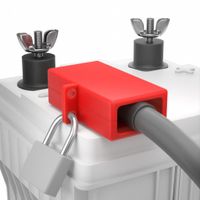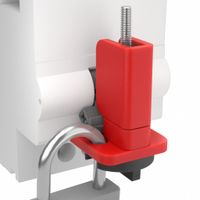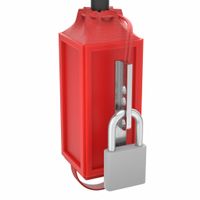Call +(254) 703 030 000 / 751 483 999 / 721 704 777
- Home
- Safety
- Lockout Tagout
- Electrical Lockout Devices
.....Read More
Frequently Asked Questions
What is the purpose of electrical lockout devices in a LOTO procedure?
The purpose of electrical lockout devices in a Lockout/Tagout (LOTO) procedure is to ensure the safety of workers by preventing the accidental energization of electrical equipment during maintenance or repair activities. These devices are critical components of a comprehensive safety protocol designed to protect employees from hazardous energy releases that could result in serious injury or death.
Electrical lockout devices physically isolate energy sources by locking them in an "off" position, ensuring that machinery or equipment cannot be powered on while maintenance work is being performed. This is achieved by placing a lockout device on the energy-isolating mechanism, such as a circuit breaker, switch, or disconnect, and securing it with a padlock. Only authorized personnel who are performing the maintenance work have the key to the padlock, ensuring that the equipment remains de-energized until the work is completed and it is safe to restore power.
In addition to preventing accidental energization, lockout devices also serve as a visual indicator that equipment is under maintenance, alerting other workers to the presence of ongoing work and the need to avoid interacting with the equipment. This reduces the risk of accidental activation by uninformed personnel.
Overall, electrical lockout devices are essential for maintaining a safe working environment, ensuring compliance with safety regulations, and protecting workers from electrical hazards. They are a fundamental part of the LOTO procedure, which is a critical safety practice in industries where machinery and equipment are routinely serviced or maintained.
How do electrical lockout devices comply with OSHA standards?
Electrical lockout devices comply with OSHA standards by adhering to the requirements set forth in the OSHA Lockout/Tagout (LOTO) standard, specifically 29 CFR 1910.147. This standard mandates the control of hazardous energy during the servicing and maintenance of machines and equipment to prevent unexpected energization, start-up, or release of stored energy that could cause injury to employees.
1. **Device Design and Durability**: Lockout devices must be durable and capable of withstanding the environment to which they are exposed. They should be standardized in color, shape, or size to ensure easy recognition and must be substantial enough to prevent removal without excessive force or unusual techniques.
2. **Identification**: Devices must clearly identify the individual who applied them. This ensures accountability and prevents unauthorized removal.
3. **Exclusive Control**: Lockout devices must be under the exclusive control of the authorized employee performing the maintenance. This ensures that only the person who applied the lock can remove it, maintaining the integrity of the lockout process.
4. **Training and Procedures**: OSHA requires that employees be trained in the purpose and use of lockout devices. Employers must develop, document, and enforce an energy control program that includes specific procedures for lockout/tagout.
5. **Periodic Inspections**: Employers must conduct periodic inspections of the energy control procedures to ensure compliance and effectiveness. These inspections help identify any deviations or inadequacies in the procedures.
By meeting these requirements, electrical lockout devices ensure the safety of workers by effectively isolating hazardous energy sources, thereby complying with OSHA standards.
What types of electrical lockout devices are commonly used?
Common types of electrical lockout devices include:
1. **Circuit Breaker Lockouts**: These devices are designed to fit over circuit breakers to prevent them from being turned on. They come in various designs to accommodate different breaker types, such as single-pole, multi-pole, and oversized breakers.
2. **Plug Lockouts**: Used to lock out electrical plugs, these devices encase the plug and prevent it from being inserted into an outlet. They are suitable for various plug sizes and types.
3. **Switch Lockouts**: These are used to lock switches in the off position. They can be applied to toggle switches, rotary switches, and other types of electrical switches.
4. **Electrical Panel Lockouts**: These devices secure electrical panels by locking the panel door, preventing unauthorized access to the circuit breakers inside.
5. **Fuse Lockouts**: Designed to prevent the removal or installation of fuses, these devices are used in fuse boxes to ensure that circuits remain de-energized.
6. **Lockout Hasps**: While not exclusively for electrical applications, lockout hasps allow multiple workers to apply their personal locks to a single energy isolation point, ensuring that the equipment cannot be re-energized until all locks are removed.
7. **Lockout Tags**: Often used in conjunction with lockout devices, tags provide information about the lockout, including the reason for the lockout and the person responsible. They serve as a warning not to operate the equipment.
8. **Cable Lockouts**: These versatile devices use a cable to secure multiple energy isolation points or to lock out large equipment. They are adaptable to various applications and can be used in conjunction with other lockout devices.
These devices are essential for ensuring safety during maintenance and repair work by preventing accidental energization of electrical equipment.
How do you properly apply a LOTO padlock to a lockout device?
To properly apply a LOTO (Lockout/Tagout) padlock to a lockout device, follow these steps:
1. **Preparation**: Ensure you have the correct lockout device for the equipment and a uniquely keyed LOTO padlock. Verify that the equipment is turned off and isolated from its energy source.
2. **Notify Affected Personnel**: Inform all affected employees about the lockout process and the equipment being serviced.
3. **Identify Energy Sources**: Locate all energy sources connected to the equipment, including electrical, hydraulic, pneumatic, and mechanical.
4. **Isolate Energy Sources**: Use appropriate lockout devices to isolate each energy source. This may involve turning off circuit breakers, closing valves, or disconnecting power sources.
5. **Apply Lockout Device**: Attach the lockout device to the energy-isolating mechanism. Ensure it is securely placed to prevent accidental re-energization.
6. **Attach LOTO Padlock**: Insert the shackle of the LOTO padlock through the designated hole on the lockout device. Close the shackle and ensure it is locked. The padlock should be applied in a way that it cannot be removed without a key.
7. **Tag the Lock**: Attach a tag to the padlock with your name, contact information, and the date. The tag should clearly state that the equipment is locked out and should not be operated.
8. **Verify Isolation**: Test the equipment to ensure it is properly isolated and cannot be turned on. This may involve attempting to start the equipment or using a test instrument.
9. **Complete Documentation**: Fill out any required lockout/tagout documentation, noting the equipment, date, and your details.
10. **Communicate**: Inform all affected personnel that the lockout is in place and the equipment is safe to work on.
11. **Perform Maintenance**: Proceed with the maintenance or repair work only after confirming the equipment is safely locked out.
What are the differences between circuit breaker lockouts and electrical-plug lockouts?
Circuit breaker lockouts and electrical-plug lockouts are both safety devices used in lockout/tagout (LOTO) procedures to ensure that machinery and equipment are properly shut off and not started up again before maintenance or repair work is completed. However, they serve different purposes and are used in different contexts.
Circuit Breaker Lockouts:
1. **Purpose**: Designed to isolate and secure circuit breakers in the "off" position to prevent accidental energization of electrical circuits.
2. **Application**: Used on circuit breaker panels, typically in industrial or commercial settings.
3. **Design**: These devices fit over the breaker switch and are secured with a padlock. They come in various designs to accommodate different types of breakers, such as single-pole, multi-pole, or oversized breakers.
4. **Material**: Usually made from durable materials like plastic or metal to withstand environmental conditions and tampering.
5. **Installation**: Requires access to the breaker panel and may need specific tools for installation, depending on the design.
Electrical-Plug Lockouts:
1. **Purpose**: Used to prevent electrical plugs from being inserted into an outlet, thereby ensuring that equipment remains de-energized.
2. **Application**: Suitable for portable equipment and tools that are powered by electrical plugs.
3. **Design**: Typically consists of a box or cover that encloses the plug and is secured with a padlock. Some designs accommodate different plug sizes and shapes.
4. **Material**: Often made from high-impact plastic to provide insulation and durability.
5. **Installation**: Simple to apply, as it involves enclosing the plug and locking the device, without the need for tools.
In summary, circuit breaker lockouts are used for securing circuit breakers, while electrical-plug lockouts are used for securing electrical plugs. Both are essential for ensuring safety during maintenance activities.
How do battery cable lockouts function to secure equipment?
Battery cable lockouts function to secure equipment by physically isolating the power source, preventing unauthorized or accidental activation. They are essential in ensuring safety during maintenance or repair work on electrical equipment. Here's how they work:
1. **Isolation**: Battery cable lockouts are designed to disconnect the battery from the equipment. This is achieved by clamping onto the battery cable, effectively cutting off the power supply. By doing so, they ensure that the equipment remains inoperative while maintenance is being performed.
2. **Physical Barrier**: These lockouts act as a physical barrier, preventing the reconnection of the battery cable to the equipment. They are typically made from durable materials like heavy-duty plastic or metal, which are resistant to tampering and environmental conditions.
3. **Locking Mechanism**: The lockout device is equipped with a locking mechanism that requires a key or combination to open. This ensures that only authorized personnel can remove the lockout, thereby controlling who can restore power to the equipment.
4. **Visibility**: Many battery cable lockouts are brightly colored or have warning labels to increase visibility. This serves as a visual deterrent and reminder that the equipment is under lockout/tagout (LOTO) procedures.
5. **Compliance**: Using battery cable lockouts helps organizations comply with safety regulations and standards, such as OSHA's LOTO requirements. This compliance is crucial for maintaining workplace safety and avoiding legal penalties.
6. **Versatility**: These devices can be used on a variety of equipment and battery types, making them versatile tools in industrial and commercial settings.
By effectively isolating the power source and preventing unauthorized access, battery cable lockouts play a critical role in ensuring the safety of personnel and the integrity of equipment during maintenance activities.
What are the steps to ensure a lockout device is not removed by unauthorized personnel?
1. **Training and Awareness**: Ensure all employees are trained on lockout/tagout (LOTO) procedures and understand the importance of not removing lockout devices unless authorized.
2. **Clear Identification**: Use lockout devices that are clearly labeled with the name and contact information of the person who applied the lock. This helps in identifying the responsible individual.
3. **Standardized Procedures**: Develop and implement standardized LOTO procedures that specify who is authorized to apply and remove lockout devices.
4. **Authorization Protocols**: Establish a list of authorized personnel who are permitted to remove lockout devices. Ensure this list is accessible and regularly updated.
5. **Unique Locks and Keys**: Use locks that have unique keys or combinations to prevent unauthorized removal. Each authorized employee should have their own lock and key.
6. **Documentation**: Maintain a log of all lockout activities, including who applied and removed each device, the date and time, and the reason for lockout.
7. **Supervision and Monitoring**: Supervisors should regularly monitor compliance with LOTO procedures and ensure that only authorized personnel are involved in lockout activities.
8. **Communication**: Implement a communication system to inform all affected employees when a lockout device is applied or removed, ensuring everyone is aware of the status of the equipment.
9. **Disciplinary Measures**: Establish and enforce disciplinary measures for unauthorized removal of lockout devices to deter violations.
10. **Regular Audits**: Conduct regular audits of LOTO procedures to ensure compliance and identify areas for improvement.
11. **Emergency Protocols**: Develop emergency procedures for situations where a lockout device must be removed by someone other than the person who applied it, ensuring it is done safely and with proper authorization.





